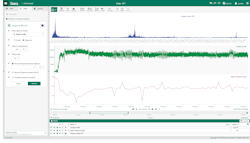New features reflect both growing use for publishing analytics-based views to other employees, and the increased complexity of the use cases where engineers use Seeq. For publishing insights, “scorecards” has been expanded; this is a feature for the display of calculated tables in Seeq Workbench and Organizer. Scorecards are used for tabulated metrics, measurements and other summary data, and may be presented in tables with conditional formatting support and user-defined columns, for example roll-ups by batch or plant. The software also adds frequency analysis capabilities with Fast Fourier Transform (FFT) to transform segments of a time-series signal into the frequency domain. Users access the frequency analysis tool via an intuitive panel that guides them through the transformation process and displays results as a power spectrum, or they can access FFT functionality as a formula in the company’s scripting environment. Examples of how an engineer could use FFT to understand variation of equipment and process include identification of process oscillations due to poorly tuned controllers or sticking control valves, of controllers oscillating with a common frequency, of process variation due to poor operation or incorrect functioning of the process or equipment and of process changes happening at common intervals, and identifying changes in these oscillations that may indicate problems.
>>For more information on this product, click here
Seeq
www.seeq.com
206.801.9339
